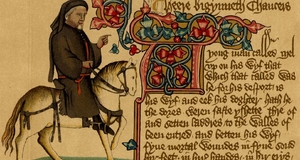Anti-Semitism and Religious Intolerance in Aristocratic Age English Literature
By
2015, Vol. 7 No. 03 | pg. 3/3 | « In John Donne’s Holy Sonnet XI, an anti-Semitic theme prevails as well in order to defend Christian belief. The narrator, speaking through the lens of Jesus, emphatically cries, “Spit in my face you Jewes, and pierce my side…My sinnes, which passe the Jews' impiety:/ They kill'd once an inglorious man” (Donne 251; 1-7). In so doing, Donne suggests that the Jews are responsible for Jesus’ death and, accordingly, depraved. Portrayed as the scapegoats for his crucifixion, Jews are unquestionably discriminated against within the work itself. Such a blatant anti-Semitic theme was not uncommon throughout Europe during Donne’s lifetime, as Jews were similarly widely blamed for the crucifixion of Jesus. In this poem, the narrator’s connoted anti-Semitic theme dramatically helps him illustrate and draw upon his impiety. By stating that his sins surpass even those of the Jews, he conjures a powerful anti-Semitic theme that unequivocally conveys the gravity of his own sin, as Jews were then perceived to be heretics and evil incarnate. Remarkably, in an unusually self-deprecating manner for those times, the narrator effectively supports his thesis by cogently debasing himself in tandem with pejorative references to Jews: “They kill'd once an inglorious man, but I/Crucify him daily” (Donne 251; 7-8). After self-flagellating himself with the aid of an anti-Semitic theme, the narrator then proceeds to further make his point by exalting God, in stark contrast, by juxtaposing the narrator’s impiety with the selflessness of God’s sacrifice for humanity. The narrator employs the crucifixion, described in the Christian Bible, to exalt God: “God clothed Himself in vile man's flesh, that so/He might be weak enough to suffer woe” (Donne 251; 13-14). By utilizing the Christian account from the New Testament to present God in an extremely favorable light, he glorifies Christianity and the attendant belief that God appeared in the form of Jesus to suffer for all of humanity. In essence, the aforementioned anti-Semitic theme ultimately helps validate Christian thought by helping to impart a Christian account in which God is exalted. By the same token, in John Milton’s Book XII of Paradise Lost, an anti-Semitic theme is also denoted, ultimately for a means of justification. Milton describes Jesus as being “to death condemnd A shameful and accurst, naild to the cross by his own nation” (Milton 412-414). These lines connote an anti-Jewish affront, echoing the Church’s anti-Semitic sentiment and erroneous assertion that Jews (rather than the Romans) killed Jesus. This misguided notion persisted for centuries throughout Europe, thereby reflecting anti-Semitic attitudes held by the Church throughout Milton’s lifetime. The implied anti-Semitic theme in this epic poem ultimately helps “justify the ways of God to men” (Milton Book I), or His wicked behavior towards men, by showing that His decisions are merely reactions to those of man. For instance, the portrayal of Jews as murderers helps depict and justify the crucifixion of Jesus. The crucifixion is illustrated in order to explain how the Christian concept of redemption arose as a result of man’s actions – in this case, the alleged malevolent actions of Jewish men. Moreover, this anti-Semitic theme validates God’s actions towards man by supporting the notion that God simply acts in response to the way man exercises his free will.Furthermore, in Geoffrey Chaucer’s The Canterbury Tales, an anti-Semitic theme is connoted as well, particularly in the Prioress’ Tale, so as to vilify the Roman Catholic Church. For instance, upon walking through the Jewish quarter of an unnamed Asian city singing a popular medieval hymn, a pious Christian boy is savagely murdered by a group of Jews influenced by Satan: “This cursed Jew seized and held him tight, and then cut his throat and cast him into a pit” (Chaucer 573). Chaucer’s tale vilifies Jews as being the attackers, causing them to appear as unworthy human beings lacking compassion or tolerance. Thus, this depiction of Jews as iniquitous murders implies a cultural prejudice against Jews. In this account, the Jews are blatantly illustrated as villainous and sinful: “He who deserves evil shall have evil” (Chaucer 634). This statement ascribes a wicked nature to Jews, thereby evincing an anti-Semitic theme. The narrator also fosters an anti-Semitic tone by repeatedly referring to the Jews as “cursed.” For instance, the boy’s mother is shown to be searching for her son “among the cursed Jews” (Chaucer 599), and another victim, Hugh of Lincoln, is described as being “slain also by cursed Jews” (Chaucer 690). Composed roughly a century after the Jews were expelled from England (1290), this work’s heavily anti-Semitic theme represents a similar contemporary Christian hatred towards Jews that perpetuated enforced edicts against Jewish learning and forced conversions of Jews. The anti-Semitic theme expressed in Chaucer’s The Prioress’ Tale ultimately serves to indirectly attack the corruption of Catholic Church officials and their practices. By being represented as attackers, the Jews are vilified, causing them to appear as unworthy human beings lacking compassion or tolerance. However, the Prioress’ negative depiction of Jews as depraved murderers, implying an anti-Semitic theme and reflecting the disparaging view of Jews at the time, actually serves to vilify the Prioress, portraying her as religiously intolerant and somewhat of a racist. Accordingly, this negative quality attributed to the Prioress can also be ascribed to Roman Catholic Church by virtue of the basic correlation between the two, considering her occupation as a nun. Therefore, the aforementioned, manifested anti-Semitic theme espouses a portrayal of the Roman Catholic Church as racist and, thus, corrupt. The use of Jews in the tale may or may not happen to be incidental. Moreover, the works of Shakespeare, Marlowe, Donne, and Chaucer raise themes of anti-Semitism to reflect contemporary cultural prejudices towards Jews and also to support a social commentary on societal views at the time. Shakespeare’s Macbeth connotes an anti-Semitic theme in order to strengthen and validate common stereotypes of witches and Jews that existed during Shakespeare’s lifetime. Likewise, Marlowe’s anti-Semitic theme in The Jew of Malta serves to justify a contemporary anti-Semitic stereotype by emulating it through Barabas. In contrast, in The Merchant of Venice, Shakespeare shrewdly manages to challenge contemporary societal views towards Jews by evoking an anti-Semitic theme. Furthermore, Donne’s Holy Sonnet XI and Chaucer’s The Prioress’ Tale raise this theme in order to glorify Christianity and attack the Roman Catholic Church, respectively. ReferencesChaucer, G. (1987). The Prioress's tale (Vol. 20). University of Oklahoma Press. Cooper, J. R. (1970). Shylock's Humanity. Shakespeare Quarterly, 117-124. Donne, J. (2000). The Complete Poetry and Selected Prose of John Donne:(A Modern Library E-Book). Modern library. Herman, E. (2007). Blood to Ink, Bread to Dust: Transformative Jewish and Christian Legends of the Middle Ages. The Pluralist, 108-126. Marcus, I. G. (2001). The Dynamics of Jewish Renaissance and Renewal in the Twelfth Century. Marlowe, C. (1976). Complete Plays and Poems, ed. Pendry and JC Maxwell. JM Dent & Sons, London. Milton, J. (2007). Paradise lost. Pearson Education. Shakespeare, W. (2001). The Tragedy of Macbeth (Vol. 2). Classic Books Company. Shakespeare, W. (2003). The Merchant of Venice. Cambridge University Press. Teall, J. L. (1962). Witchcraft and Calvinism in Elizabethan England: Divine Power and Human Agency. Journal of the History of Ideas, 21-36. Holocaust.(2015). In Encyclopædia Britannica. 15th Ed. Vol. 3. 592. Print. “Anti-Semitism: Marrano.” (2007) In Encyclopaedia Britannica. 15th Ed. Vol. 7. 871. Print. “Anti-Semitism: Roman Catholic History.” (2006) The New Encyclopaedia Britannica. 15th Ed. Vol. 26. 884. Print. “Anti-Semitism: Spain.” (2007) The New Encyclopaedia Britannica. 15th Ed. Vol. 28. 38. Print. Suggested Reading from Inquiries Journal
Inquiries Journal provides undergraduate and graduate students around the world a platform for the wide dissemination of academic work over a range of core disciplines. Representing the work of students from hundreds of institutions around the globe, Inquiries Journal's large database of academic articles is completely free. Learn more | Blog | Submit Latest in Literature |
















